Dekalb-Peachtree Airport (PDK)
Dekalb-Peachtree Airport (PDK) is a primarily general aviation airport located fifteen miles north-northeast of Hartsfield-Jackson Atlanta International Airport (ATL). PDK hosts a high volume of corporate/general aviation jet traffic as well as pilot training operations for approximately ten flight schools based on the field. There is a robust helicopter community, providing tours of the city, daily traffic watch reports, and primary helicopter flight instruction. View a printable Pilot Handbook of the PDK information found on this Web page.
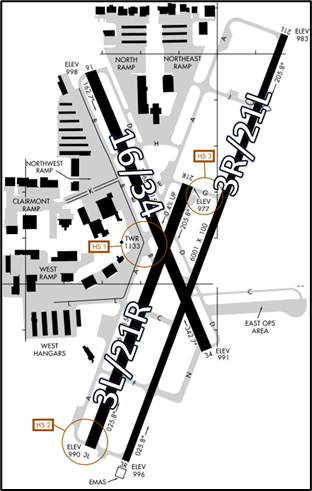 Know Before You Go
Know Before You Go
- The RWY configuration consists of closely spaced parallel RWYs with staggered thresholds labeled 3L/21R and 3R/21L. A third RWY labeled RWY 16/34 crosses both parallel RWYs. (See illustration)
- The airspace at PDK is Class D and underlies Atlanta Class B airspace. (Refer to Sectional Chart)
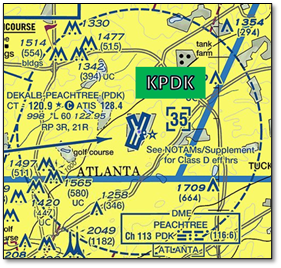
Below find various PDK-specific information and things to be aware of, as well as general information to inform your preflight planning. This will be reviewed quarterly and updated as needed. This information is to supplement the From the Flight Deck Videos that are produced by the FAA Runway Safety Group. Here you will also find information provided by the local air traffic controllers at the airport where you intend to fly. The information is subject to change. Not for navigation or legal* pre-flight action. Always refer to official pre-flight materials such as, but not limited to, NOTAMs, airport diagrams, VFR charts and airport construction notices for the latest airport-specific details.
PDK ATCT 0630L-2300L M-F / 0700L-2300L S-S
Administrative Office 0800L to 1600L M-F
Business Phone 678-495-5230
Hot Spots
-
HS1 Southbound traffic on TWY B will miss the turn onto TWY A when assigned RWY 3L or RWY 3R.
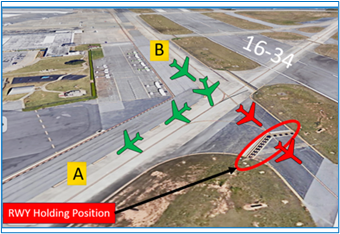
-
HS2 Pilots expecting RWY 3R often fail to hold at RWY 3L.
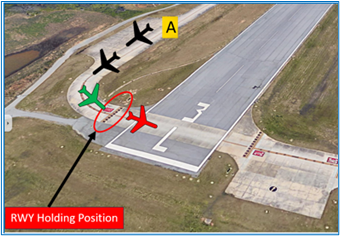
-
HS3 Aircraft exiting RWY 3R/21L at TWY G and instructed to hold short of RWY 3L/21R often enter the RWY without authorization.
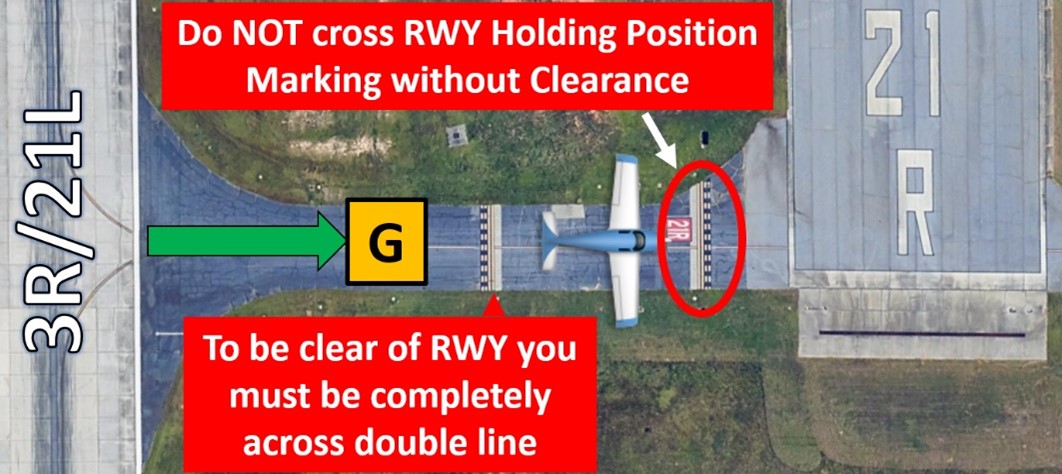
- To completely exit the RWY you must be completely across the double line.
- Pilots exiting RWY 3R/21L can expect to hold short of RWY 3L/21R on TWR frequency.
- View From the Flight Deck – Complex Airfield Geometry #5: Short Distance Between Parallel Runways video.
Wrong RWY Landing Risk (See Arrival Alert Notices (AAN).
- Wrong RWY Landing risk exists due to closely spaced parallel RWYs.
- Be aware of staggered thresholds on RWYs 21L/R.
- Review NOTAMS Letter to Airmen LTA-PDK-7 “Verify Aligned with Correct Runway”.
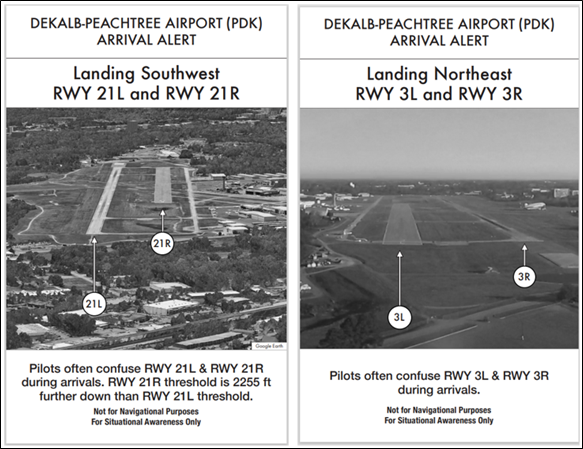
Wrong Surface Landing Risk
- TWYs that parallel RWYs, increasing the risk of landing on a TWY.
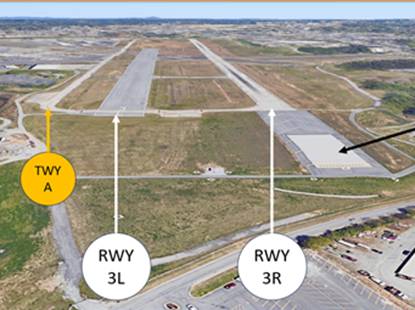
- TWY A parallels the entire length of RWY 3L/21R.
- TWYs B and D parallel RWY 16/34

- When available, back up all visual approaches with an instrument approach to help ensure that you are lined up for the correct surface.
- RWY markings are white. Markings on surfaces not used for takeoff/landing like TWY markings, chevrons, RWY shoulder and RWY turn-on markings etc., are yellow.
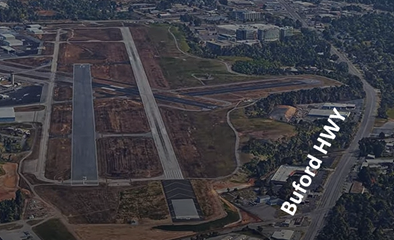 Additional Wrong Surface Landing Risk
Additional Wrong Surface Landing Risk
- At night, pilots may confuse Buford HWY as RWY 3R/21L since the lights on the highway are brighter than the lights at the airport.
- When available, back up all visual approaches with an instrument approach to help ensure that you are lined up for the correct surface.
- View From the Flight Deck-Wrong Surface Landings video for more information.
Wrong Runway Departure Risk
- View the From the Flight Deck-Wrong Direction Intersection Takeoffs video for more information and mitigation strategies.
Surface Risk-Movement Area
- Pilots that have landed on one of the parallel RWYs and taxiing to the West/Northwest Ramps with instructions to hold short RWY 16/34 at TWYs A or E, have missed the hold short line and entered RWY 16/34.
- Pilots assigned RWY 21R taxi via TWYs A/G have missed the hold short line and entered RWY 21R without clearance.
- Aircraft leaving the run-up area at the juncture of TWY E and TWY A have missed the hold short line on TWY G and entered RWY 21R.
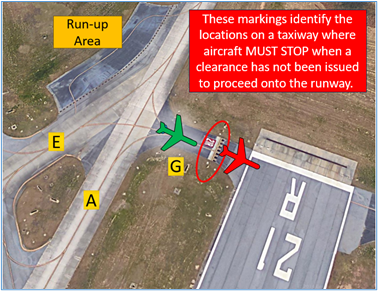
General Information
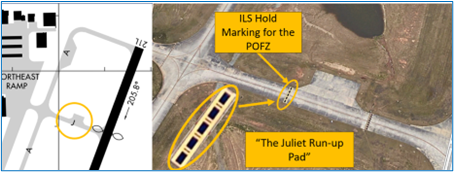 The ILS hold bar on TWY A short of RWY 21L is meant to protect the Obstacle Clearance Surface when an arriving aircraft is within two miles of the RWY. The weather requirements for this hold line are the same as for an ILS hold line (Ceiling less than 800 feet and visibility less than 2 miles). TWR may instruct departing aircraft to pull up to the RWY Hold Short line if no aircraft are on final.
The ILS hold bar on TWY A short of RWY 21L is meant to protect the Obstacle Clearance Surface when an arriving aircraft is within two miles of the RWY. The weather requirements for this hold line are the same as for an ILS hold line (Ceiling less than 800 feet and visibility less than 2 miles). TWR may instruct departing aircraft to pull up to the RWY Hold Short line if no aircraft are on final.- The standard location for maintenance engine runs is in the run-up pad on TWY Juliet (“The Juliet run-up”). This area falls within the Precision Obstacle Free Zone (POFZ) and must be protected when the ceiling is less than 300 feet, or the visibility is less than 3/4 miles.
- Anytime an aircraft performs a run-up in the Juliet pad, the operator must ensure that the aircraft fuselage is parallel to RWY 21L and the engines are facing north.
Traffic Patterns
- Single engine small aircraft pattern altitude is 2000’ MSL.
- High performance turboprop and jet pattern altitude is 2500’ MSL.
- RWY 3R and RWY 21R are RIGHT TRAFFIC.
- RWY 3L and RWY 21L are LEFT TRAFFIC.
Ground Control (GC)
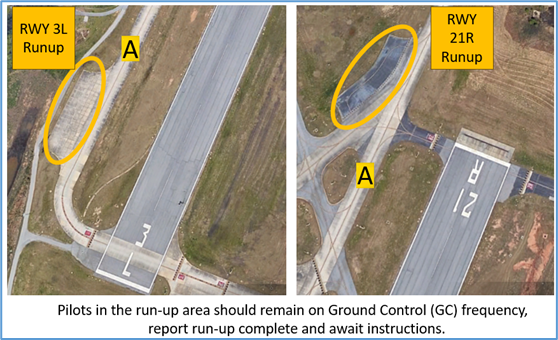 All ramps (including Taxi-lanes K and L) are non-movement areas and are uncontrolled.
All ramps (including Taxi-lanes K and L) are non-movement areas and are uncontrolled.- Two run-up pads are positioned across TWY A and prior to the hold line at the approach ends of RWY 3L/21R.
- While in the run-up area, remain on GC and report run-up complete and await instructions.
- Specify whether IFR or VFR departure when calling Ground Control (GC) for taxi.
- When the TWR is open, Clearance Delivery (CD) is only available on CD (125.2) or GC (121.6). The frequency is specified on the ATIS. Do not call 120.9 for clearance when the TWR is open.
- Aircraft requesting VFR flight following should contact GC stating your cardinal direction of flight (e.g., NW, SW, SE, N, etc.). GC will issue taxi instructions and advise flight following will be available once airborne on 126.97 but only after TWR switches you over.
- All VFR aircraft will request taxi from GC with call-sign, type aircraft, parking location, the ATIS and cardinal VFR direction of flight.
Takeoff/Departure
- IFR aircraft expect an initial altitude of 3000’ MSL. TWR will issue an initial departure heading once IFR release is received from the TRACON.
- VFR traffic departing RWY 3L/21R must maintain RWY track unless otherwise instructed by ATC and be vigilant for jet traffic departing the parallel RWY.
- VFR helicopters can expect to depart either the helipad (Charlie Pad) or depart directly from the ramp at the pilot’s own risk.
- TWR may restrict helicopter departures to “at or below” 1500’ MSL for traffic in the pattern.
Arrival/Landing
- VFR aircraft from the east may be instructed to cross midfield at or above 2000’ MSL or 2500’ MSL to enter the downwind for RWY 3L/21R. This is to procedurally separate inbound aircraft from aircraft arriving and departing. The inbound aircraft crossing midfield must ensure they cross the RWY complex at the midpoint from east to west.
- Arriving aircraft must be aware of aircraft arriving to the parallel RWY on a straight in or opposing base. TWR will issue traffic until the pilot reports the traffic in sight.
- PDK has experienced numerous TCAS resolution advisory (RA) events due to aircraft flying through the assigned parallel RWY final.
- To the maximum extent possible, VFR aircraft conducting practice instrument approaches will be provided standard IFR separation by Atlanta Approach.
Special Traffic-Helicopters
- VFR helicopters will be instructed by Approach Control to enter a boundary of the airport (East/West/North/South). After being switched to the TWR, helicopters should advise the TWR where they are parking and expect a clearance or landing advisory shortly after.
- Pilots should be aware of occasional military and civilian aircraft conducting overhead maneuvers at PDK. The overhead pattern is at 2500’ MSL.
- There is a robust sightseeing, pilot training, news/traffic reporting, and MEDEVAC helicopter presence at PDK. Taxiing aircraft should use caution for rotor wash. Many helicopters depart directly from and land directly on the ramp areas.
Avoidance Areas
- When RWY 3R/L are in use, VFR aircraft should avoid:
- The area between PDK355° and PDK035° radials between 4 and 6NM at 3000’ MSL due to IFR jet departures on a RWY Heading or a 360° heading climbing to 3000’ MSL.
- The area between 3 and 6 miles southeast of the airport at 3000’ MSL for IFR arrival jet traffic.
- When RWY 21L/R are in use VFR aircraft should avoid:
- The area 5NM northeast of PDK (PDK030° radial) between 2500’ MSL and 3500’ MSL because IFR aircraft on the ILS approach are descending from AABEE (PDK 030/12.3 DME) out of 3000’ MSL, crossing CHAMB (PDK030/6.2 DME) at 2900’ MSL and continuing to descend to the RWY.
- The area 3 miles southeast of PDK between 2500’ MSL and 3000’ MSL for IFR eastbound jets departing RWY 21L with a 090° heading climbing to 3000’ MSL.
VFR pilots should avoid “skirting the Delta”. The high volume of VFR and IFR traffic in and out of PDK makes it imperative for aircraft on the edge of the Class D to monitor/contact the TWR, especially between 2000’ MSL and 3000’ MSL.
Additional Information
- Engineered Material Arresting System (EMAS) located at the Departure End of RWY 21L.
- RWY 21L has a displaced threshold.
NOTAMS
- See NOTAMS for the following Letters to Airmen (LTA):
- Obtaining IFR Clearances from Atlanta Approach
- Overshooting Parallel Runway Final
- Verify Aligned with Correct Runway
- VFR Aircraft Conducting Practice Approaches
- Runway Incursions at Taxiway Golf Between Runway 3R/21L and Runway 3L/21R
